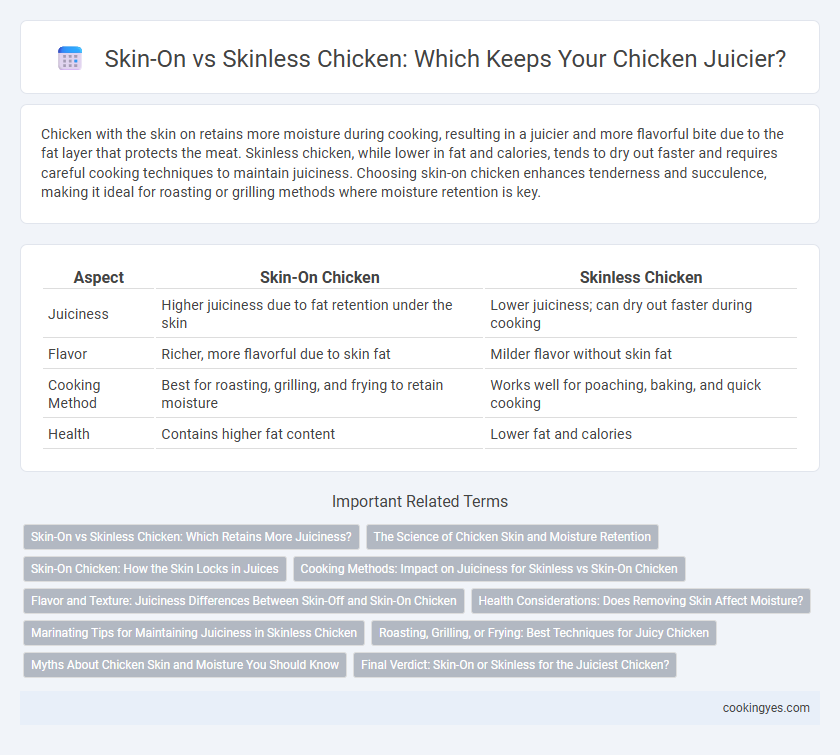Chicken with the skin on retains more moisture during cooking, resulting in a juicier and more flavorful bite due to the fat layer that protects the meat. Skinless chicken, while lower in fat and calories, tends to dry out faster and requires careful cooking techniques to maintain juiciness. Choosing skin-on chicken enhances tenderness and succulence, making it ideal for roasting or grilling methods where moisture retention is key.
Table of Comparison
| Aspect | Skin-On Chicken | Skinless Chicken |
|---|---|---|
| Juiciness | Higher juiciness due to fat retention under the skin | Lower juiciness; can dry out faster during cooking |
| Flavor | Richer, more flavorful due to skin fat | Milder flavor without skin fat |
| Cooking Method | Best for roasting, grilling, and frying to retain moisture | Works well for poaching, baking, and quick cooking |
| Health | Contains higher fat content | Lower fat and calories |
Skin-On vs Skinless Chicken: Which Retains More Juiciness?
Skin-on chicken retains more juiciness during cooking because the skin acts as a natural barrier, preventing moisture loss and enhancing flavor retention. In contrast, skinless chicken tends to dry out faster as it lacks this protective layer, requiring careful cooking techniques like marinating or brining to maintain moistness. Studies show that the fat content and collagen in skin contribute significantly to juiciness and tenderness in cooked chicken.
The Science of Chicken Skin and Moisture Retention
Chicken skin contains a high level of fat and collagen, which significantly contribute to moisture retention during cooking, resulting in juicier meat. The skin acts as a natural barrier, preventing water loss and helping to trap steam, enhancing tenderness and flavor. Studies show skin-on chicken retains up to 20% more moisture compared to skinless cuts, making it ideal for roasting or grilling to achieve succulent texture.
Skin-On Chicken: How the Skin Locks in Juices
Skin-on chicken retains moisture more effectively during cooking as the fat layer beneath the skin acts as a natural barrier, preventing juices from evaporating. This protective skin layer helps maintain the meat's tenderness and enhances flavor by locking in essential fats and juices. As a result, skin-on chicken delivers a juicier and more flavorful eating experience compared to its skinless counterpart.
Cooking Methods: Impact on Juiciness for Skinless vs Skin-On Chicken
Cooking methods significantly impact the juiciness of skin-on versus skinless chicken, with skin-on chicken retaining more moisture during roasting and grilling due to the protective fat layer under the skin. Skinless chicken benefits from slow-cooking methods like braising or poaching, which help maintain its tenderness by preserving moisture without the insulating effect of the skin. High-heat methods such as frying or broiling can dry out skinless chicken quickly, whereas skin-on chicken stays juicy longer because the skin acts as a barrier against direct heat.
Flavor and Texture: Juiciness Differences Between Skin-Off and Skin-On Chicken
Skin-on chicken retains more moisture during cooking, resulting in juicier meat with a richer, more flavorful experience due to the fat rendered from the skin. Skinless chicken tends to have a leaner texture but can dry out faster, often leading to a less tender bite without the added fat layer. The presence of skin not only enhances juiciness but also creates a crispy texture that complements the tender meat beneath.
Health Considerations: Does Removing Skin Affect Moisture?
Chicken skin contains fat that helps retain moisture during cooking, contributing to juicier meat, while skinless chicken tends to dry out faster if not cooked carefully. Removing the skin reduces calorie and fat intake, which benefits heart health but may require techniques like brining or marinating to preserve juiciness. Health-conscious cooking methods such as baking or grilling skin-on chicken allow flavor and moisture retention without excessive fat consumption.
Marinating Tips for Maintaining Juiciness in Skinless Chicken
Marinating skinless chicken in an oil-based marinade with acidic ingredients such as lemon juice or vinegar helps retain moisture and enhances juiciness by breaking down muscle fibers. Incorporating ingredients like yogurt or buttermilk in the marinade increases tenderness and prevents dryness during cooking. Ensuring adequate marinating time--typically 30 minutes to 2 hours--allows the flavors to penetrate deeply, making skinless chicken more succulent and flavorful.
Roasting, Grilling, or Frying: Best Techniques for Juicy Chicken
Roasting chicken with the skin on locks in moisture, creating a crispy exterior while preserving juicy, tender meat inside. Grilling skin-on chicken shields the meat from direct heat, reducing dryness and enhancing flavor through caramelization. When frying, the skin crisps rapidly, sealing in juices and producing a succulent bite, whereas skinless chicken requires careful marination or brining to maintain juiciness during high-heat cooking methods.
Myths About Chicken Skin and Moisture You Should Know
Chicken skin is often thought to be the main factor in retaining juiciness, but moisture primarily depends on cooking techniques rather than the presence of skin. Studies show that overcooking skinless chicken causes dryness, while properly cooked skinless cuts can be just as juicy as skin-on. The myth that skin preserves moisture ignores the importance of internal temperature control and resting time for optimal chicken tenderness.
Final Verdict: Skin-On or Skinless for the Juiciest Chicken?
Skin-on chicken retains more moisture during cooking due to the fat layer beneath the skin, resulting in a juicier texture compared to skinless chicken. Cooking methods like roasting or grilling benefit from the skin's ability to protect the meat from direct heat, enhancing flavor and succulence. For maximum juiciness, skin-on chicken is the preferred choice.
Skin-on vs Skinless for Chicken Juiciness Infographic

 cookingyes.com
cookingyes.com